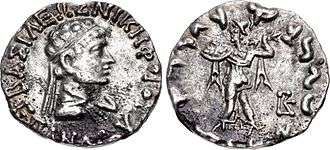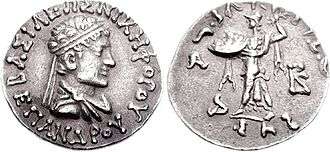Epander
Epander (Greek: Ἔπανδρος) was one of the Indo-Greek kings. He may have been a relative of Menander I, and the findplaces of his coins seem to indicate that he ruled in the area of Punjab.
| Epander Nikephoros ("Victorious") | |
|---|---|
 Portrait of Epander. | |
| Indo-Greek king | |
| Reign | 95–90 BC |

Coin of Epander. Greek legend: ΒΑΣΙΛΕΩΣ ΝΙΚΗΦΟΡΟΥ ΕΠΑΝΔΡΟΥ "Of the Victorious King Epander".

Coin of Epander. Greek legend: ΒΑΣΙΛΕΩΣ ΝΙΚΗΦΟΡΟΥ ΕΠΑΝΔΡΟΥ "Of the Victorious King Epander".

Indian-standard coin of Epander. Greek legend: ΒΑΣΙΛΕΩΣ ΝΙΚΗΦΟΡΟΥ ΕΠΑΝΔΡΟΥ "Of the Victorious King Epander".
Time of reign
Bopearachchi dates Epander to c. 95–90 BC and R. C. Senior to c. 80 BC. The scarcity of his coins indicate that his reign was short and/or his territory limited.
Coins of Epander
Epander's silver drachms portray the king in diadem with a reverse of Athena fighting which was the type of Menander I. Epander probably claimed ancestry from this important king, but his epithet Nikephoros (Victorious) was unique to kings using this reverse: their title was usually Soter (Saviour). He struck no Attic (monolingual) coins.
Overstrikes
Epander overstruck coins of Strato I and Philoxenus.
gollark: Terrariola's potatoes.
gollark: Don't worry. Support teams are standing by.
gollark: Where ground is defined as water.
gollark: *That* is the underground base network.
gollark: Oh, that.
See also
References
- The Greeks in Bactria and India, W.W. Tarn, Cambridge University Press.
External links
| Preceded by Philoxenus |
Indo-Greek ruler in Punjab 95–90 BCE |
Succeeded by Apollodotus II |
- O. Bopearachchi, "Monnaies gréco-bactriennes et indo-grecques, Catalogue raisonné", Bibliothèque Nationale, Paris, 1991, p.453
- Quintanilla, Sonya Rhie (2 April 2019). "History of Early Stone Sculpture at Mathura: Ca. 150 BCE - 100 CE". BRILL – via Google Books.
This article is issued from Wikipedia. The text is licensed under Creative Commons - Attribution - Sharealike. Additional terms may apply for the media files.